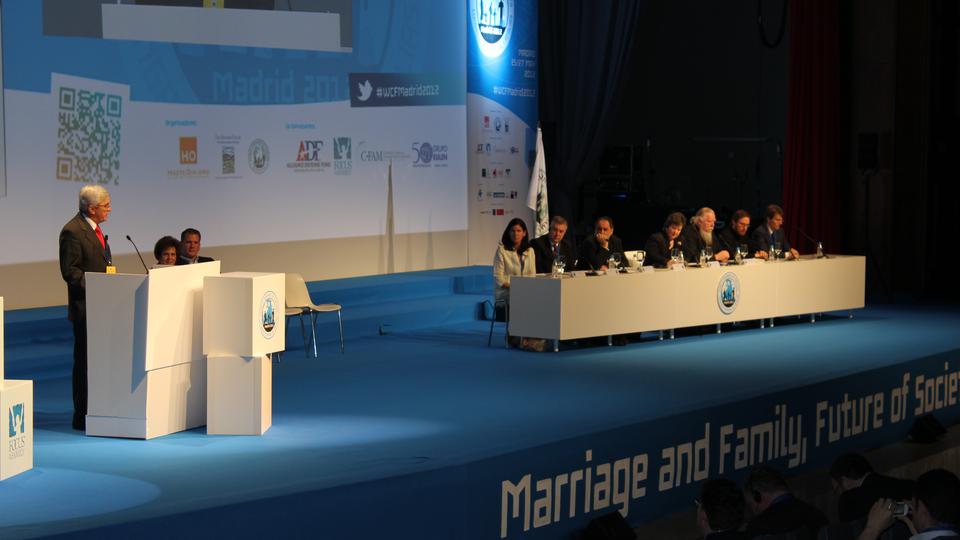This week, the 7th World Congress of Families is being held in Sydney. The program, from Wednesday night 15th May to Saturday afternoon 18th May, features speakers from around the world on issues affecting the modern family and aims to bring emphasis to the natural family in Australia and around the Pacific.
| Elder Erich W. Kopischke, a Seventy and president of the Europe Area of The Church of Jesus Christ of Latter-day Saints (second from left on at the speakers' table), spoke at the 2012 World Congress of Families VI in Madrid, Spain (photo, courtesy of Ángel José Gómez García). 2013 by Intellectual Reserve, Inc. All rights reserved. | 1 / 6 |
Among those addressing the audience are 100 religious leaders, scholars, politicians, parenting and family practitioners, educators, business people, film and media experts, actors and fashion designers. The Sydney congress is being held at the Australian Technogy Park, Eveleigh, NSW.
The World Congress of Families, founded in 1997 by the Howard Centre for Family, Religion and Society in Rockford, Illinois, has become one of the most significant events in the world supporting the natural family. The WCF previously has been held in Prague, Geneva, Mexico City, Warsaw, Amsterdam and Madrid. The Church of Jesus Christ of Latter-day Saints is one of a number of sponsors of this year’s event in Sydney.
Larry Jacobs, managing director of the World Congress of Families, said “One of the important features of the event, wherever it has been held in the past, has been its ability to cause a shift in the debate on family issues in the host country. The organisers expect this will happen in Australia and New Zealand and some of the Pacific Island nations as a result of the Congress being held in this region.”
Patrons of the Congress are: former politician John Anderson, Rabbi Dr Shimon Cowen, Jim Dominguez, Ian and Mary Grant (NZ), Andrew Forrest, chairman of Australia mining company Fortescue Metals Group, Cardinal George Pell, and Francisco Tatad (Philippines).
One of the keynote speakers of this year’s event is Peter Meurs, currently the director of development for Fortescue Metals Group. Elder Meurs is an Area Seventy, a senior priesthood officer in The Church of Jesus Christ of Latter-day Saints. Also speaking is Lloyd Newell, a professor at Brigham Young University and the host of the weekly “Music and the Spoken Word” broadcast by the Mormon Tabernacle Choir.
The following commentary on the family unit, sourced from the Church’s global website, Mormonnewsroom.org, gives an insight into current trends regarding the family.
A house in want of order
“In the coming decades, success will accrue to those cultures that preserve the family’s place.” Joel Kotkin [1]
We hear it all the time: “The family is the basic unit of society.” But do we, as a society, really think about what that means? The bonds between husband and wife, parents and children, are so firmly planted in history and experience that we often take them for granted — until, as happens from time to time, those bonds break down. As a solid body of research shows, there is no replacement for the way this institution creates and develops human relationships. Family is no longer, nor ever has been, something that is simply “granted.” As anyone who has tried it knows, raising a family and sustaining a marriage are challenging things to do. However, at stake is not only the health of the individual family but also the prosperity and future of society.
Social scientists agree that not all is well with family and marriage. A report on a recent national survey captured the mood: “America’s parents are anxious.”[2] And as the report shows, anxiety about family decline taps into “a larger perception that our communities are less safe, our work ethic has slipped, and American religious and spiritual life has ebbed.”[3]
The institutions of family and marriage are wearing down. Marriage rates continue to decline[4]: the average couple marrying today has a 40-50 percent chance of divorce or separation.[5] Cohabitation is increasingly commonplace[6] and when children are involved results in more break-ups than marriage.[7] Around 41 percent of all births take place outside of marriage[8] and for the first time more than half of births to women under 30 occur outside marriage.[9] The institutions that are meant to provide security have become a source of insecurity. As many as 44 percent of those in the millennial age group agree that marriage is becoming “obsolete.”[10]
But what does this portend? The health of marriage also has economic implications. According to Pew Research, “married adults have made greater economic gains over the past four decades than unmarried adults.”[11] In addition, children in single-parent households are more likely to live in poverty.[12] But children in two-parent families around the world tend to have better educational outcomes than those living with only one parent or without a parent.[13] Of course not all families are alike, and it takes mutual commitment and community support for even the best of them to work.
Marriage and children, now and in the future
While society is blessed by the contributions of virtuous citizens from all walks of life, research indicates that married people tend to be happier, healthier, and more productive, and they provide the best environment for raising children.[14] Children raised by their own married biological parents experience less poverty, less drug and alcohol use and less crime and delinquency; they gain more education; they are more likely to marry; and they have better mental health compared with children from other family arrangements.[15]
The presence of children in families and societies summons responsibility for their care, encourages productivity, creates an orientation toward the future and pulls individuals outside of their own needs. Though not every couple has children, whether by choice or by circumstance, children remind us all that human flourishing goes much deeper than the happiness of the present. Fortunately, in the United States most children born to married couples will grow up in an intact family.[16] What one spiritual leader said years ago still holds true today: the greatest work we will ever do is within the walls of our home.[17]
But what happens when children no longer become a normal part of life’s plans and patterns? The answer is not just smaller families, but smaller populations. Birth rates have been falling in many places around the world, including the United States. Declining birth rates are making it hard for many Asian and European countries, for example, to replace one generation with another. A report called “The Rise of Post-Familialism” — a condition in which "the family no longer serves as the central organizing feature of society” — describes “a huge population” of people around the world “who have no offspring.” Choosing not to have children, these people “may be less focused on those things necessary to assure a better future for the next generation.”[18] The state of the family figures into a whole spectrum of societal problems, including demographic, economic and sociological.
Stable families as cooperative unions
One might think that family matters are entirely personal, detached from the surrounding society. Does one person’s family or marriage really affect anyone else’s? The answer is a resounding yes. None of us lives in isolation. A report on the state of marriage in America put it this way: “Marriage is not merely a private arrangement; it is also a complex social institution. Marriage fosters small cooperative unions — also known as stable families — that enable children to thrive, shore up communities, and help family members to succeed during good times and to weather the bad times.”[19]
David Brooks of the New York Times goes further, explaining how maximizing personal freedom does not necessarily give people what they want. Rather, he argues, individuals are better served “when they are enshrouded in commitments that transcend personal choice — commitments to family, God, craft and country.”[20]
None of us is born a mere individual. We come to this world with a network of pre-existing relationships, bonds and obligations, both familial and civil. Eighteenth-century statesman Edmund Burke affirmed that society acts as “a partnership not only between those who are living, but between those who are living, those who are dead, and those who are to be born."[21] As Orthodox rabbi Meir Soloveichik sees it, family works in much the same way: “Marriage is about continuity and transmission.”[22] The hard, humble work of building and strengthening family relationships is worth undertaking, not only for ourselves but also for the common good.
If these trends remain unaltered …
If current trends continue, what will the family look like 10, 20 years down the road? What kind of future awaits our children, our young people, our neighbourhoods and civic relationships? These are serious problems that need to be addressed — not when crisis boils over completely, but now. Projections are notoriously difficult for social scientists to make. The future is not set in stone; society falls into slumps and climbs back out of them. However, given the current trajectory the future looks pretty bleak for many American children.
Demographer Joel Kotkin sings a similarly somber tune: “It’s time for us to consider what an aging, increasingly child-free population, growing more slowly, would mean here. As younger Americans individually eschew families of their own, they are contributing to the ever-growing imbalance between older retirees—basically their parents—and working-age Americans … creating a culture marked by hyper-individualism and dependence on the state as the family unit erodes.”[23] Calling family “truly indispensable,” Kotkin says that strengthening it is “a case we need to make as a society, rather than counting on nature to take its course.”[24]
This discussion on family is much more than a numerical exercise; it’s about the lives and hopes of real people. These societal drifts need not be our destiny. Yet, as one commentator recently noted, such pervasive trends “can only be reversed by the slow accumulation of individual choices, which is how all social and cultural recoveries are ultimately made.”[25]
--------------------------------------------------------------------------------
[1] Joel Kotkin and Harry Siegel , “Where Have All the Babies Gone?” The Daily Beast, Feb. 19, 2013.
[2] Carl Desportes Bowman, James Davison Hunter, Jeffrey S. Dill, Megan Juelfs-Swanson, “Culture of American Families,” Executive Report, Institute for Advanced Studies in Culture, 2012.
[3] Ibid.
[4] U.S. Census Bureau, “America’s Families and Living Arrangements,” Current Population Reports, 2011, Table A1.
[5] Paul R. Amato and Stacey J. Rogers, “Do Attitudes Toward Divorce Affect Marital Quality?” Journal of Family Issues 20 (1999): 69-86.
[6] Sheila Kennedy and Larry Bumpass, “Cohabitation and Children’s Living Arrangements: New Estimates from the United States,” Demographic Research 19 (2008): 1663-92. Also, recent data from the National Center for Health Statistics of the U.S. Department of Health and Human Services similarly demonstrate the growing trend of cohabitation. See Linda and Richard Eyre, “The Cancerous Curse of Cohabitation,” Deseret News, Apr. 24, 2013.
[7]Kay Hymowitz, Jason S. Carrol, W. Bradford Wilcox, Kelleen Kaye, “Knot Yet: The Benefits and Costs of Delayed Marriage in America,” 2013, 10.
[8] Elizabeth Wildsmith, Ph.D., Nicole R. Steward-Streng, M.A., Jennifer Manlove, Ph.D., Child Trends, Research Brief, “Childbearing Outside of Marriage: Estimates and Trends in the United States,” 2011.
[9] Ibid.
[10] Joel Kotkin and Harry Siegel , “Where Have All the Babies Gone?” The Daily Beast, Feb. 19, 2013.
[11] Pew Research Social & Demographic Trends, “Women, Men, and the New Economics of Marriage,” Jan. 19, 2010.
[12] Federal Interagency Forum on Child and Family Statistics, “America’s Children in Brief: Key National Indicators of Well-Being, 2012,” Washington, DC: U.S. Government Printing Office, 2012.
[13] Laura H. Lippman, W. Bradford Wilcox, “World Family Map 2013: Mapping Family Change and Child Well-Being Oucomes,” An International Report from Child Trends.
[14] See Linda J. Waite and Maggie Gallagher, The Case for Marriage: Why Married People Are Happier, Healthier, and Better off Financially (2000).
[15] Ibid.
[16] W. Bradford Wilcox, “The Evolution of Divorce,” National Affairs, 2009, 88.
[17] Harold B. Lee, Strengthening the Home, pamphlet, 1973, 7.
[18] Joel Kotkin, Anuradha Shroff, Ali Modarres, Wendell Cox, Zina Clapper, “The Rise of Post-Familialism: Humanity’s Future,” 2012, 1, 24.
[19] Institute for American Values, The National Marriage Project, “The State of Our Unions: Marriage in America” 2012, Executive Summary.
[20] David Brooks “The Age of Possibility,” New York Times, Nov. 15, 2012.
[21] Edmund Burke, Reflections on the Revolution in France, 1790.
[22] David Brooks “The Orthodox Surge,” New York Times, Mar. 7, 2013.
[23] Joel Kotkin and Harry Siegel , “Where Have All the Babies Gone?” The Daily Beast, Feb. 19, 2013.
[24] Ibid.
[25] Ross Douthat, “More Babies, Please,” New York Times, Dec. 1, 2012.







